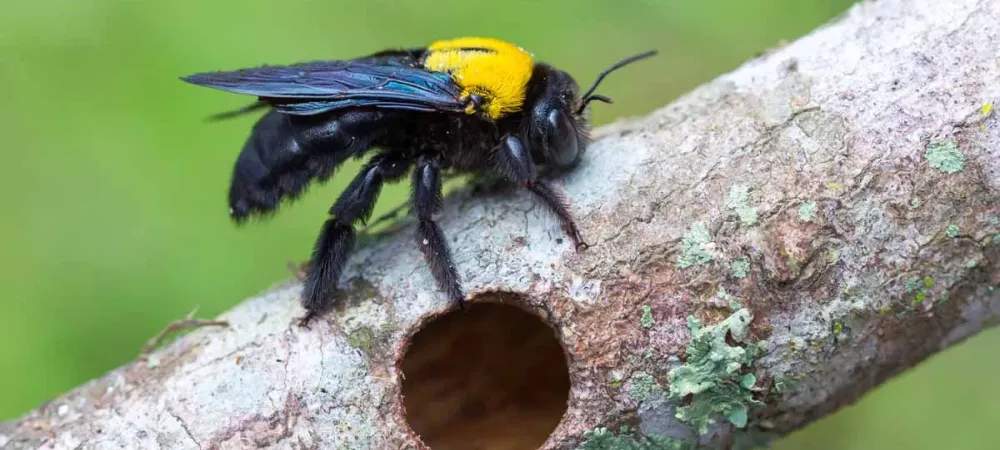Signs of Carpenter Bees Around Your Home

In the warm spring and summer months of Western New York, carpenter bees are a common occurrence around our gardens, decks, and patios. Knowing some facts about them can help you identify these harmful bees and get rid of them as soon as possible.
Difference between carpenter bees and bumblebees
Like other native bees, they are essential pollinators for plant communities and can play an important role in crop pollination. Unlike native bees, however, carpenter bees nest in tunnels chewed into wood and can be destructive when nests are constructed in wooden siding, decks, fence posts, or other wooden structures. Carpenter bees are often confused with bumblebees because of similarities in both size and color. However, carpenter bees have smooth, shiny black abdomens without fuzz whereas bumblebees tend to be fuzzy all over. Carpenter bees get their common name from their nesting habits. Eastern species prefer to nest in soft woods such as cedar, redwood, cypress, pine, and fir. Western species are more commonly found nesting in hardwoods such as oak, eucalyptus, and redwood. Despite their preferences, all species of carpenter bees are much less likely to nest in painted or pressure-treated lumber of any type.
Where they nest
Carpenter bees overwinter as adults in nest tunnels and emerge in mid to late spring. After mating, the female locates a suitable nest site and begins by chewing a perfectly round entrance hole into the wood. She then excavates tunnels about five inches long that are provisioned with balls of pollen to serve as food for the larvae, and the tunnels are sealed. The larvae feed and develop in the tunnels before emerging as adults in late summer and the process begins again. Mated females may enlarge and reuse old nest tunnels for egg-laying or excavate new tunnels.
Signs of carpenter bees in your home
Considerable damage can occur to wood that has been utilized as a nesting site year after year. Knowing how to identify carpenter bees and their nesting habits is key to protecting your home and your property from costly wood damage.
- First, you can recognize the entrance to a carpenter bee nest because the hole is about a half-inch in diameter and looks perfectly drilled.
- Second, carpenter bees make quite a mess when excavating a nest by leaving deposits of leftover wood below the hole. They also can cause noticeable staining to the area outside the entrance with yellow/brown pollen and feces.
- Lastly, male bees are often seen hovering around or just outside of the nest entrance in order to protect the female inside the nest. So, spotting a hovering carpenter bee could indicate that a nest is nearby.
Both male and female carpenter bees can be territorial and may dive-bomb anyone that comes near their nest. The good news however is that female carpenter bees rarely sting unless provoked. Males do not have a stinger and do not sting at all. Still, most homeowners do not want to have aggressive insects around to potentially cause damage to structures. Make sure to contact Eco Serve at [phone-number] at the first signs of bee activity on your property to identify, treat, and prevent further carpenter bee damage to your home. Our technician's service West Seneca, Williamsville, and the surrounding Buffalo, NY area.

